SECURITIES AND EXCHANGE COMMISSION
Washington, D.C. 20549
FORM 6-K
REPORT OF FOREIGN PRIVATE ISSUER PURSUANT
TO RULE 13A-16
OR 15D-16 OF THE SECURITIES EXCHANGE ACT OF 1934
For the month of April, 2024
(Commission File No. 1-14862 )
BRASKEM S.A.
(Exact Name as Specified in its Charter)
N/A
(Translation of registrant's name into English)
Rua Eteno, 1561, Polo Petroquimico de Camacari
Camacari, Bahia - CEP 42810-000 Brazil
(Address of principal executive offices)
Indicate by check mark whether the registrant
files or will file annual reports under cover Form 20-F or Form 40-F.
Form 20-F ___X___ Form 40-F ______
Indicate by check mark if the registrant is
submitting the Form 6-K
in paper as permitted by Regulation S-T Rule 101(b)(1). _____
Indicate by check mark if the registrant is
submitting the Form 6-K
in paper as permitted by Regulation S-T Rule 101(b)(7). _____
Indicate by check mark whether the
registrant by furnishing the information contained in this Form is also thereby furnishing the information to the Commission pursuant
to Rule 12g3-2(b) under the Securities Exchange Act of 1934.
Yes ______ No ___X___
If "Yes" is marked, indicate below the file number assigned to the registrant in connection with Rule 12g3-2(b): 82- _____.
BRASKEM S.A.
Corporate Taxpayer ID (CNPJ): 42.150.391/0001-70
Company Registry: 29.300.006.939
Publicly Held Company
MATERIAL FACT
PRODUCTION & SALES REPORT
FIRST QUARTER 2024
São Paulo, April 26, 2024 – Braskem S.A. (“Braskem” or “Company”) reports to its shareholders and the market its Production & Sales Report for the first quarter of 2024. Note that the information herein is based on preliminary data and that figures were not revised by the Company's independent auditor.
For more information, contact Braskem’s Investor Relations Department by calling +55 (11) 3576-9531 or emailing braskem-ri@braskem.com.br.
Contents
| 1. OPERATIONAL OVERVIEW 1Q24 | 2 |
| 2. PERFORMANCE BY SEGMENT | 2 |
| 2.1 BRAZIL/SOUTH AMERICA | 2 |
| 2.2 UNITED STATES & EUROPE | 5 |
| 2.3 MEXICO | 6 |
| 3. PETROCHEMICAL SPREADS | 8 |
| 1. | OPERATIONAL OVERVIEW 1Q24 |
During 1Q24, most of the spreads in the international petrochemical market increased compared to 4Q23, mainly due to (i) seasonal effects such as the winter storm in the Gulf region of the United States; and (ii) the conflict in the Red Sea impacting international freight and resins prices on the international market.
Regarding operating performance in the first quarter of 2024, the utilization rates at the petrochemical complexes in Brazil were higher when compared to 4Q23 due to the normalization of production after a maintenance shutdown in Bahia and the higher feedstock availability in Triunfo. In Mexico, the utilization rate remained in line with the previous quarter, as a result of the maintenance of feedstock availability in the period. With regard to the USA and Europe, the utilization rate in the quarter was lower, mainly due to the unscheduled shutdown of a PP plant in the USA, for which production was normalized at the end of February.
In this context, sales volumes were higher in Brazil and Mexico, mainly due to the higher availability of products for sale in the period and the adjustment of demand following the seasonality observed in the last quarter of 2023. In the USA & Europe, sales volume remained in line with the previous quarter, due to the optimization of inventory levels in the USA.
| 2. | PERFORMANCE BY SEGMENT |
| 2.1 | BRAZIL/SOUTH AMERICA |
Average utilization rate of petrochemical crackers: increase compared to 4Q23 (+8 p.p.) explained by (i) the resumption of operations at the Bahia petrochemical plant after a scheduled maintenance shutdown in 4Q23; and (ii) higher feedstock availability at the Rio Grande do Sul petrochemical complex. In relation to 1Q23, the decrease (-3 p.p.) is explained mainly by the adjustment of production to face lower global demand.

Resin sales volume: In the Brazilian market, the increase in resin sales volume compared to 4Q23 (+7%) is explained mainly by higher demand for PE and PP due to the rebuilding of inventories in the chain. In relation to 1Q23, the reduction (-5%) is explained mainly by prioritizing sales with higher added value in the period.
|
|

Exports were lower compared to 4Q23 (-8%) and 1Q23 (-10%), mainly due to the prioritization of the Brazilian market.
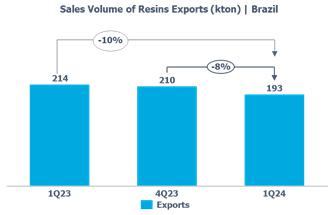
Main chemicals sales volume 1 : in the Brazilian market, sales were higher in relation to 4Q23 (+19%) mainly due to (i) higher gasoline sales volume explained by better opportunities in the Brazilian market; (ii) higher paraxylene sales volume due to the normalization of clients production, which were on a scheduled shutdown in 4Q23; (iii) higher benzene sales volume due higher demand from clients in the plastics and fibers sector; and (iv) higher demand for butadiene from clients in the elastomers sector. In relation to 1Q23, the reduction (-5%) is explained mainly by (i) lower benzene and cumene sales volume due to lower demand; and (ii) lower gasoline sale volume due to lower product availability for sale.
1 Main chemicals refer to: ethylene, propylene, butadiene, cumene, gasoline, benzene, toluene and paraxylene due to the representation of these products in the segment’s net revenue.
|
|
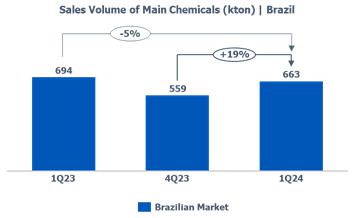
Exports were lower (-9%) compared to 4Q23 and 1Q23 (-5%), mainly due (i) the lower toluene sales volume as a result of better commercial opportunities in the Brazilian market; and (ii) prioritizing the Brazilian gasoline market.
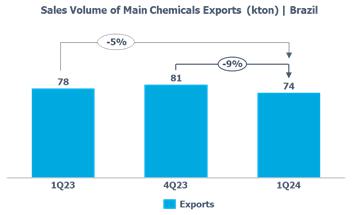
Average utilization rate of green ethylene 2: compared to 4Q23, the increase (+36 p.p.) is mainly explained by the normalization of ethanol supply after restrictions in 4Q23 due to the climate conditions in the region. Increase compared to 1Q23 (+89 p.p.) explained by the scheduled maintenance shutdown during 1Q23 for the conclusion of the project for expanding green ethylene production capacity by 30%.
2 Due to the conclusion of the project to expand in 30% green ethylene capacity at the Rio Grande do Sul unit, the calculation of the utilization rate for 1T23 considers the production capacity of 200 kt/year, and for 4Q23 and 1Q24 considers the production capacity of 260 kt/year.
|
|
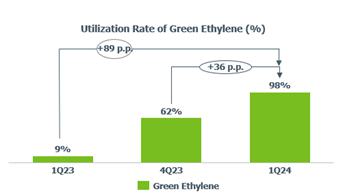
Green PE sales volume: decrease when compared to 4Q23 (-8%), mainly due to seasonality during Chinese New Year. Compared to 1Q23, the increase in sales volume (+22%) is mainly explained by the higher availability of products for sale given the return to operation after the scheduled maintenance shutdown in 1Q23 for the conclusion of the project for expanding production capacity.
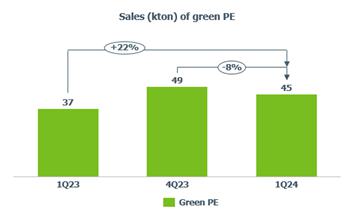
| 2.2 | UNITED STATES & EUROPE |
Average utilization
rate of PP plants: decrease when compared to 4Q23 (-6 p.p.) and 1Q23
(-5 p.p.), mainly explained by the unscheduled shutdowns of a plant in the United States, which lasted around one month between January
and February. Production has been normalized in February.

|
|
PP sales volume: remained in line with 4Q23 (-1%) and was lower compared to 1Q23 (-2%) due to inventory optimization, which partially offset the lower availability of products for sale in the United States due to an unscheduled shutdown in the region.
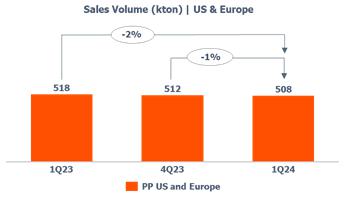
| 2.3 | MEXICO |
Average utilization rate of PE plants: in line with 4Q23 (-1 p.p.), due to the increase in the volume of ethane imported through the Fast Track solution, which was compensated by the lower supply of ethane by PEMEX, but in line with the contractual average volume established of 30 thousand barrels per day. Increase compared to 1Q23 (+11 p.p.) mainly due to the higher volume of imported ethane under the Fast Track solution, of approximately 23 thousand barrels per day, compared to 12 thousand barrels per day during 1Q23.
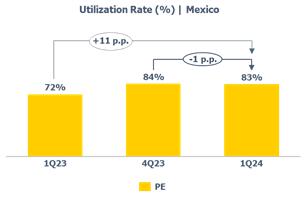
PE sales volume: sales volume was higher compared to 4Q23 (+17%), mainly due to seasonality and replenishment of PE stocks in 4Q23. In relation to 1Q23, the increase (+6%) is primarily explained by the higher availability of products for sale in the period.
|
|
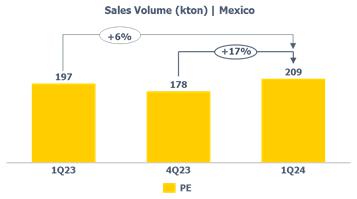
|
|
| 3. | PETROCHEMICAL SPREADS |

|
|
BRAZIL/SOUTH AMERICA
° The price of PE in the US was higher (+12%) compared to 4Q23, impacted by (i) the increase in the cost of local feedstock due to the decrease in the level of production at petrochemical complexes in the region, as a result of unscheduled shutdowns caused by winter storm Heather, which occurred in January in the US Gulf region; and (ii) an increase in the price of PE, due to higher export opportunities for US producers as a result of the conflicts in the Red Sea.
° The price of naphtha ARA increased (+6%) compared to 4Q23, following the increase in the price of oil on the international market, impacted by (i) the rise of geopolitical tensions in the Middle East; and (ii) lower refinery operating rates, due to the weather event in the United States in January (winter storm Heather).
° In relation to the first quarter of 2023, the spread was higher (+4%), mainly due to the lower price of naphtha (-3%) in the period.
° The price of PP in Asia was higher (+5%) compared to 4Q23, impacted by (i) the lower supply of imported resin into the region; and (ii) the increase in propylene and naphtha costs in the period.
° The price of naphtha ARA increased (+6%) compared to 4Q23 due to 4Q23 due to the factors mentioned above.
° Compared to the same quarter in 2023, the spread decreased (-13%) due to lower PP prices in Asia (-6%), as a result of (i) lower demand; and (ii) the supply increase due to new capacities coming online.
° The price of PVC in Asia fell (-2%) compared to 4Q23, impacted by lower demand due to (i) the Chinese New Year; and (ii) the real estate crisis in China. These effects were partially offset by the increase in the price of caustic soda in the US (+2%), explained by the balance between stable demand and limited supply, as a result of maintenance shutdowns at assets located in the US Gulf.
° Compared to 1Q23, the PVC Par spread was lower (-53%), impacted by (i) lower demand; and (ii) the lower price of caustic soda in the United States (-51%), explained by demand remaining weak in the paper, pulp, and aluminum sectors, and by the rise in the feedstock price.
3 (US PE Price – naphtha ARA price)*82%+(US PE Price – 50% US ethane price – 50% US propane price)*18%.
4 Asia PP price – Naphtha ARA price.
5 The PVC Par spread better reflects the profitability of the Vinyl business, which is more profitable compared to the temporary/nonintegrated business model of 2019/20, under which the Company imported EDC and caustic soda to keep serving its customers. Its calculation formula is: Asia PVC Price + (0.685*US Caustic Soda) - (0.48*Europe Ethylene) - (1.014*Brent).
|
|
° The price of the main chemicals was higher (+5%) compared to 4Q23, mainly impacted by (i) the higher price of gasoline (+13%) due to lower inventory levels of the product in the United States, as a result of refinery maintenance shutdowns in the region; (ii) the higher price of propylene (+18%), impacted by lower supply due to scheduled and unscheduled shutdowns at PHDs in the United States; and (iii) the recovery in the price of butadiene (+6%), due to supply restrictions as a result of operational problems at a producer in the region.
° Compared to 1Q23, the Main Basic Chemicals spread was lower (-2%), impacted mainly by (i) lower gasoline prices in Brazil (-6%), and (ii) the lower price of butadiene (-28%) due to the higher imbalance between global supply and demand.
UNITED STATES AND EUROPE
° In relation to the same quarter of the previous year, the spread remained in line.
° The price of PP in Europe was higher (+3%) compared to 4Q23 due to the lower volume of resin imported into the region caused by the logistical restrictions related to the conflict in the Red Sea. On the other hand, the price of European propylene remained in line compared to 4Q23.
° Compared to the same quarter of the previous year, the spread was higher (+8%) mainly due to the lower price of propylene in Europe (-5%) in 1Q24, explained by lower demand at the beginning of 2024, associated with increased production after lower production levels in 2023.
MÉXICO
° The price of PE in the US was higher (+12%) than in 4Q23, as explained above.
° In addition, the price of ethane was lower (-15%), in line with the reduction in the price of natural gas due to the milder winter and the oversupply caused by the extraction of associated gas in the Permian
° Compared to the same period last year, the spread was higher (+5%), impacted mainly by the lower price of ethane (-23%), which was impacted, in addition to the reasons mentioned above, due to logistical restrictions related to the drought in the Panama Canal, partially restricting the flow of gas exports from the United States Gulf.
[6] Average price of base chemicals (Ethylene (20%), Butadiene (10%), Propylene (10%), Cumene (5%), Benzene (20%), Paraxylene (5%), Gasoline (25%) and Toluene (5%), based on Braskem’s sales volume mix) – naphtha ARA price.
[7] U.S. PP – U.S. propylene price
[8] EU PP – EU propylene price
[9] U.S. PE – U.S. ethane price
|
|
SIGNATURES
Pursuant to the requirements of the Securities Exchange Act of 1934, the registrant has duly caused this report to be signed on its behalf by the undersigned, thereunto duly authorized.
Date: April 26, 2024
| BRASKEM S.A. | |||
| By: | /s/ Pedro van Langendonck Teixeira de Freitas | ||
| Name: | Pedro van Langendonck Teixeira de Freitas | ||
| Title: | Chief Financial Officer | ||
FORWARD-LOOKING STATEMENTS
This Material Fact may contain forward-looking statements. These statements are not historical facts but rather are based on the current view and estimates of the Company's management regarding future economic and other circumstances, industry conditions, financial performance, and results, including any potential or projected impact regarding the geological event in Alagoas and related legal procedures on the Company's business, financial condition, and operating results. The words “project,” “believe,” “estimate,” “expect,” “plan,” “objective,” and other similar expressions, when referring to the Company, are used to identify forward-looking statements. Statements related to the possible outcome of legal and administrative proceedings, implementation of operational and financing strategies and investment plans, guidance on future operations, the objective of expanding its efforts to achieve the sustainable macro-objectives disclosed by the Company, as well as factors or trends that affect the financial condition, liquidity or operating results of the Company are examples of forward-looking statements. Such statements reflect the current views of the Company's management and are subject to various risks and uncertainties, many of which are beyond the Company’s control. There is no guarantee that the events, trends, or expected results will actually occur. The statements are based on various assumptions and factors, including, but not limited to, general economic and market conditions, industry conditions and operating factors, availability, development, and financial access to new technologies. Any change in these assumptions or factors, including the projected impact from the joint venture and its development of technologies, from the geological event in Alagoas and related legal procedures, and the unprecedented impact on businesses, employees, service providers, shareholders, investors, and other stakeholders of the Company could cause effective results to differ significantly from current expectations. For a comprehensive description of the risks and other factors that could impact any forward-looking statements in this document, especially the factors discussed in the sections, see the reports filed with the Brazilian Securities and Exchange Commission (CVM). This Material Fact does not constitute any offer of securities for sale in Brazil. No securities may be offered or sold in Brazil without being registered or exempted from registration, and any public offer of securities carried out in Brazil must be made through a prospectus, which would be made available by Braskem and contain detailed information on Braskem and its management, as well as its financial statements.